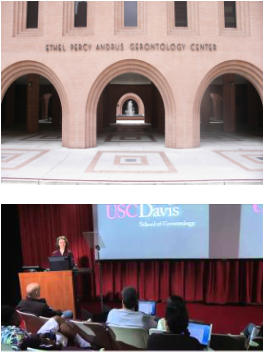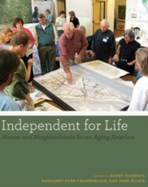
A couple of weeks ago, several members of the Design Alliance for Accessible Sustainable Environments (DAASE) attended a symposium on the campus of the University of Southern California presented by the USC / Davis School of Gerontology and the Ethel Percy Andrus Gerontology Center.
Nearly 150 people from a variety of backgrounds including interior designers, builders, occupational and physical therapists attended the daylong conference, which featured knowledgable speakers, a panel discussion, breakout sessions on design and workshops on topics related to the conference’s theme of aging in place and universal design.
Several attended the event specifically to hear the keynote address by Henry Cisneros, a former mayor of San Antonio, the former Secretary of the Department of Housing and Urban Development( HUD) and the author of a well written book, Independent For Life: Homes and Neighborhoods For An Aging America.
In his 20 minute address to the crowded auditorium, he passionately spoke of his own personal experiences with his late mother, her desire to remain in the family home as she grew on in years and remain in the surrounding neighborhood where she has raised her family, had many close friends and attended church.
Cisneros’ story was beautifully told but it wasn’t a story particularly unique to him. Studies by AARP and others consistently show that the majority of older Americans prefer to age in place, in the homes and communities of their choice. And in a most recent survey, 90% of Baby Boomers would prefer to remain in their own place for as long as possible. But the question may be: Are our homes, neighborhoods and communities equipped to meet the needs of growing numbers of older Americans?
The answer is a resounding NO! The architecture of most American homes, a substantial number built between 1946 and 1964 to answer the need of a growing population of fathers and mothers and their Boomer Babies, were not designed to adapt, accommodate nor anticipate the physical needs of Boomers in their later years.
American traditional and ranch style architecture, popular designs of the era, features steps leading up to a front porch, small halls, narrow doors and sunken living rooms, each of which creates obstacles that can impede mobility and reduce one’s personal independence.
Nearly 150 people from a variety of backgrounds including interior designers, builders, occupational and physical therapists attended the daylong conference, which featured knowledgable speakers, a panel discussion, breakout sessions on design and workshops on topics related to the conference’s theme of aging in place and universal design.
Several attended the event specifically to hear the keynote address by Henry Cisneros, a former mayor of San Antonio, the former Secretary of the Department of Housing and Urban Development( HUD) and the author of a well written book, Independent For Life: Homes and Neighborhoods For An Aging America.
In his 20 minute address to the crowded auditorium, he passionately spoke of his own personal experiences with his late mother, her desire to remain in the family home as she grew on in years and remain in the surrounding neighborhood where she has raised her family, had many close friends and attended church.
Cisneros’ story was beautifully told but it wasn’t a story particularly unique to him. Studies by AARP and others consistently show that the majority of older Americans prefer to age in place, in the homes and communities of their choice. And in a most recent survey, 90% of Baby Boomers would prefer to remain in their own place for as long as possible. But the question may be: Are our homes, neighborhoods and communities equipped to meet the needs of growing numbers of older Americans?
The answer is a resounding NO! The architecture of most American homes, a substantial number built between 1946 and 1964 to answer the need of a growing population of fathers and mothers and their Boomer Babies, were not designed to adapt, accommodate nor anticipate the physical needs of Boomers in their later years.
American traditional and ranch style architecture, popular designs of the era, features steps leading up to a front porch, small halls, narrow doors and sunken living rooms, each of which creates obstacles that can impede mobility and reduce one’s personal independence.
 Book by Henry Cisneros
Book by Henry Cisneros In Cisneros’s remarks, he asked those attending to consider that “the sheer size of the baby boom generation guarantees that, as the health and mobility of so many begin to deteriorate, communities could be saddled with enormous burden. What can be done quickly and affordably to support successful aging in communities throughout the United States? What will be our plan for supporting the oldest of the old among us?
We learned that there is no easy answer with no one perfect solution but to begin with one client, one home at time and provide each with options that support their quality of life,... ideas like creating building earthen berms for pathways that lead to front entry thereby getting rid of steps; and opening up interior spaces by eliminating doors and when possible and economical, widening halls to maximize passageways. But there is more that can be done beyond just remodeling current housing and building new homes for accessibility and safety.
The impact of the 76 million Boomers and the change it will have on our culture requires us to consider how to retrofit existing neighborhoods to connect needed services and amenities, and make plans for new communities that work well for people of all ages and all abilities.
In his concluding remarks, Cisneros said,
“We, as a nation, must examine ways to support aging in place for the unprecedented numbers of older Americans seeking to live healthy and contributing lives in communities that serve all ages. Americans are aging in traditional homes, neighborhoods and communities that were designed for yesterday’s demographic realities, not those of today or in the future.”
“Homes can be retrofitted, new age-appropriate homes built, existing neighborhoods reconnected and new communities planned. Financial strategies must adapt to new needs and opportunities. Public opinion must be better aligned with the values of accessibility, affordability, connectivity and diversity. All levels of government must address these challenges with bold solutions.”
The members of the Design Alliance For Accessible Sustainable Environments couldn’t agree more.
We learned that there is no easy answer with no one perfect solution but to begin with one client, one home at time and provide each with options that support their quality of life,... ideas like creating building earthen berms for pathways that lead to front entry thereby getting rid of steps; and opening up interior spaces by eliminating doors and when possible and economical, widening halls to maximize passageways. But there is more that can be done beyond just remodeling current housing and building new homes for accessibility and safety.
The impact of the 76 million Boomers and the change it will have on our culture requires us to consider how to retrofit existing neighborhoods to connect needed services and amenities, and make plans for new communities that work well for people of all ages and all abilities.
In his concluding remarks, Cisneros said,
“We, as a nation, must examine ways to support aging in place for the unprecedented numbers of older Americans seeking to live healthy and contributing lives in communities that serve all ages. Americans are aging in traditional homes, neighborhoods and communities that were designed for yesterday’s demographic realities, not those of today or in the future.”
“Homes can be retrofitted, new age-appropriate homes built, existing neighborhoods reconnected and new communities planned. Financial strategies must adapt to new needs and opportunities. Public opinion must be better aligned with the values of accessibility, affordability, connectivity and diversity. All levels of government must address these challenges with bold solutions.”
The members of the Design Alliance For Accessible Sustainable Environments couldn’t agree more.

 RSS Feed
RSS Feed